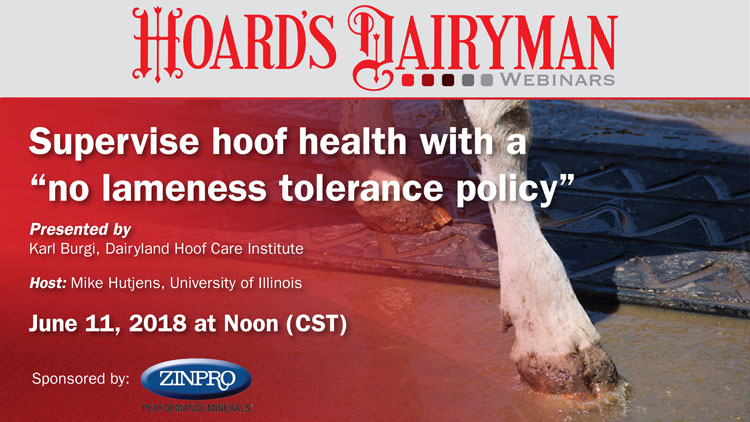
Well-respected hoof care specialist, Karl Burgi, presented the June webinar, “Supervise hoof health with a ‘No lameness tolerance policy.’” He shared the mistakes that can put cows at risk and how to prevent foot issues from arising.
One case of lameness has a price tag of $527. That figure takes loss of milk production, discarded milk, extra days open, additional labor, treatment costs, and early culling into account. The loss of milk production is by far the largest impact of lameness.
The most common sources of lameness are digital dermatitis (hairy warts), sole ulcers, white line lesions, toe ulcers, and foot rot (interdigital phlegmon).
How do you know if lameness is an issue on your operation? Locomotion scoring is a good start; it begins with watching the cow move – her gait, back position, and so forth. It will help the producer evaluate each cow on a standardized scale. While each cow will have a score, the overall herd’s hoof health will also be realized through the process. Burgi stated that, “It is vital to have records to better manage hoof health, either written or electronic. “With no records, you cannot make good management decisions,” he reiterated.
Several slides were shown to demonstrate correct hoof trimming, and improper techniques including trimming toes too close, excessive trimming, removal of the inside wall at the toe, excessive removal of the outer wall, and trimming the soles too thin.
Cows with inflammation after trimming may have been trimmed too short. One thing to remember is that housing has changed over the years, and hoof trimming has been impacted. In tie stall barns, cows do not travel much, but freestall cows walk far more often and over longer distances. Hoof trimming techniques must account for housing differences.
Calving time is the highest risk for inflammation. Cows should have functional hoof trimming done eight to three weeks prior to calving. While some people are leery of trimming a cow that late in gestation, Burgi was comfortable with the recommendation. Some extra gentleness may be needed, but he did not want producers to avoid this window of time. “There should be no lameness issues in the close up pen,” Burgi stated. These cows should not be overcrowded and have comfortable stalls or lying areas.
The manure handling system where animals are housed has a big impact on hoof health. Healthy skin is a great defense against hoof diseases, and keeping cows’ feet away from standing manure is a key factor in controlling lameness.
Burgi noted that alley scrapers are the worst option if you are trying to keep cows from standing in or stepping through manure. Slatted floors are designed to have manure drop through normal walking activity. Often times, though, sufficient manure does not get worked down and then a buildup provides a source of waste for cows to travel through. Flush systems with recycled water work well, but should be used when cows are away from the pens.
“Do everything on the preventative side,” stressed Burgi. That was even more strongly urged in organic herds, as the option to treat cows with antibiotics is not allowed.
When transitioning heifers on pasture to confinement pens precalving, he suggested having them on concrete for six to eight weeks before calving to develop the fat pad in their hoof. He urged producers to not make this change at the time of calving, but plan well ahead to give the soon-to-be milking cow time to adjust to the different flooring dynamics.
In addition to trimming the cow when she is dry, he also suggested one to two more trims during lactation. Burgi’s five take home messages were:
- Identify digital dermatitis (DD) early and treat first lesion with topical antibiotic
- Observe breeding heifers for DD
- Use a well-managed hoof bath
- Ensure hoof bath chemicals proves efficacy
- Ensure hoof bath chemical does not promote skin hyperkeratosis
He concluded with this message, “Treat lameness within 24 hours!”
This webinar was sponsored by Zinpro Performance Minerals.
This presentation can be viewed here.
Join us next month

Ev Thomas, Oak Point Agronomics, will present “The lowdown on reduced-lignin alfalfa” on Monday, July 9, at noon (Central time).
There’s considerable interest in reduced-lignin alfalfa, which comes from both genetically modified varieties and those developed using conventional plant breeding. Reduced-lignin alfalfa can provide very high-quality forage, but it requires harvest timing decisions, may be used in grass mixtures, and has a ration impact. Register at www.hoards.com/webinars
This presentation will be sponsored by HarvXtra.

The author is the online media manager and is responsible for the website, webinars, and social media. A graduate of Modesto Junior College and Fresno State, she was raised on a California dairy and frequently blogs on youth programs and consumer issues.








